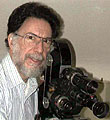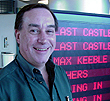|
|
This topic comprises 2 pages: 1 2
|
|
Author
|
Topic: Recommend the finest Multiplex Architect around
|
|
|
|
|
|
|
|
|
|
|
|
|
|
|
|
|
|
|
|
|
|
|
|
|
Gerard S. Cohen
Jedi Master Film Handler

Posts: 975
From: Forest Hills, NY, USA
Registered: Sep 2001
|
 posted 09-21-2003 04:34 PM
posted 09-21-2003 04:34 PM




Kamakshipalya,
I've thought about the design of the interiors of multiplex auditoriums. Most are pretty utilitarian, with a couple of exceptions.
I note one chain which has designated a two-color scheme, used in all auditoriums, involving the woven designs on the upholstery,curtains and wall drapes. This produces a brand image and unifies all auditoriums within a given multiplex, but at the expense of creating a generic and boring lack of specific space.
The more outstanding exception was achieved by Sony Theatres at Lincoln Center, New York City, when they bought control of Loews' Theatres and built that vertical high riser close to the Lincoln Center of the Performing Arts.
In the 1930's the Loews chain built a series of huge movie palaces (single-screens, of course), each lavishly decorated in the style of a different exotic locale. I remember Loews' Valencia, Paradise, Azteca, Egyptian, etc, each with wall and ceiling sculpture, columns, pilasters, etc.; fountains and goldfish ponds, and planetarium projectors to throw moving images of stars, clouds and the moon on the ceiling. These theatres were later cut up into multiplexes and demolished.
What Sony did at their Lincoln Center 12-plex was to stack their auditoriums vertically on both sides of an immense stainless-steel escalator, each with an individualized entrance fascade representing the decor of one of the Loews palaces, and bearing not the designation Theatre #1 through Theatre #12, but each room with the name of the movie palace it memorialized. (The last auditorium to open to the public was an IMAX theatre.) [Pictures in the F-t archive]
How might this translate to India? I know there are many real palaces in India, but have only stayed at one in Indore, so I don't know if they are popular, the way the Taz Mahal is in the public's imagination. Might each auditorium bear the name and
entrance decor of an Indian palace or historic building?
Then too, I notice every Indian popular film has a lovers' honeymoon montage where the camera shows Juhu Beach, pine forests, snowcapped Himalayas, Kashmiri lakes, and every beautiful type of landscape in the sub-continent, while the lovers croon to each other, or the descendants of the Mangescar singers provide vocal interlude. Could these supply names and decor for individualizing your multiplex auditoriums?
Namaste,
Gerard
| IP: Logged
|
|
Kamakshipalya Dhananjay
Expert Film Handler

Posts: 190
From: Bangalore, India
Registered: Aug 2002
|
 posted 09-22-2003 09:31 AM
posted 09-22-2003 09:31 AM




A truly great idea !
But then, the Multiplexes coming up in other states are all glass and steel structures and the interiors in them are so full of dazzling lights and neon, the Indian public has come to see the Multiplexes as incorporating advancements in architecture involving glass and steel. So, it is unlikely here that any of the existing or upcoming Multiplexes would incorporate images or designs inspired by historic buildings or structures.
Also, the nature as captured in most of the Bollywood and South Indian films is hardly of the Indian variety in recent years. It is now customary for Indian producers to shoot most of their outdoor songs in the Europe, Australia, Canada or the South Africa. And the Indian audience can readily identify if the location featured in a given film is a place in India or outside.
Therefore, the race is now to build Multiplexes that compellingly look modern and new age.
I have to admit however that I feel some of the upcoming Multiplexes in the United States are a class apart from the existing ones there or even in comparison with those in other parts of the world. That we intend to build, whereever we do, a composite structure comprising of a mall, multiplex, a live theatre, speciality shops, restaurants and cafes, we are looking towards some of the upcoming works in the United States and to the people, principally the architect and the designer.
The building technology and design profession in India is evidently very backward when compared with even places like Thailand, Taiwan or Malaysia. Sooner or later, the Government of India will allow foreign Multiplex operators to build and operate Multiplexes here. As of now, the law lays down that foreign companies may not hold more than 49 % of the equity and that the control and management of the Multiplexes so built shall vest with a Resident Indian person, firm or company. So, it is our plan that we have to build such works that compare with the best in any part of the world. So, in a way, we need to compete with Multiplexes coming up there in the US !
| IP: Logged
|
|
Martin Brooks
Jedi Master Film Handler

Posts: 900
From: Forest Hills, NY, USA
Registered: May 2002
|
 posted 09-22-2003 07:46 PM
posted 09-22-2003 07:46 PM





quote:
What Sony did at their Lincoln Center 12-plex was to stack their auditoriums vertically on both sides of an immense stainless-steel escalator, each with an individualized entrance fascade representing the decor of one of the Loews palaces, and bearing not the designation Theatre #1 through Theatre #12, but each room with the name of the movie palace it memorialized. (The last auditorium to open to the public was an IMAX theatre.) [Pictures in the F-t archive]
While it's a multi-story building, most of the theaters are on one level and they're not on both sides of the escalator, as the escalator is in the very front of the building. Below ground level are three smaller screens, used mainly for more specialist films. Those three screens are named for former Loews theaters in New Jersey are are named The Canal, The Palace, and The Jersey, The ground level contains the main lobby, ticket area, automated ticket machines and a small gift stand.
The escalator takes one up to the main theater level where there are 9 additional screens in a "T" formation. These are the "Loews" (which has a balcony and was originally THX certified), the Kings, State, Olympia, Valencia, Capitol, Paradise, Avalon and Majestic. There is a large painted mural along the wall that adjoins the escalator. When you come off the top of the escalator, there is a large, round customer service desk and the main entranceway to these nine theaters. The entranceway is meant to replicate the feel of entering the MGM lot. As you enter the entranceway, the main screen is behind you on your right at an angled entrance. The entrance brings you into another hallway, for which there is another entrance into the actual theater and a staircase up to the balcony.
Back in the main hallway, there are four screens on the left side and a very large concession stand on the right. The other four screens are at the end of the hallway at the top of the "T". Including the smaller screens in the lower level, the theaters vary in size from 140 to 964 seats. The Loews features a curved screen 62.5' wide.
Taking the escalator up to the top level brings one to the entrance of the IMAX theater.
Although this is a beautiful multiplex and a very good place to see movies in NYC, one would think from the original publicity that they replicated the interior architecture of the original theaters in each of the screens and that is certainly NOT the case. These are not "wonder theaters" as seven of the original Loews theaters in NYC were originally described and they're not movie palaces. But it is very nice and certainly goes beyond the architecture in a typical multiplex.
Each screen has a metal plaque outside the entrance featuring an etched image of the original theater and some text with its history. There are some art-deco flourishes over the entrance to each screen and towards the front of each theater. The Loews has a bit more of these elements than the other screens and also has a little "light show" before each presentation.
| IP: Logged
|
|
|
|
All times are Central (GMT -6:00)
|
This topic comprises 2 pages: 1 2
|
Powered by Infopop Corporation
UBB.classicTM
6.3.1.2
The Film-Tech Forums are designed for various members related to the cinema industry to express their opinions, viewpoints and testimonials on various products, services and events based upon speculation, personal knowledge and factual information through use, therefore all views represented here allow no liability upon the publishers of this web site and the owners of said views assume no liability for any ill will resulting from these postings. The posts made here are for educational as well as entertainment purposes and as such anyone viewing this portion of the website must accept these views as statements of the author of that opinion
and agrees to release the authors from any and all liability.
|

 Home
Home
 Products
Products
 Store
Store
 Forum
Forum
 Warehouse
Warehouse
 Contact Us
Contact Us




 Printer-friendly view of this topic
Printer-friendly view of this topic
















